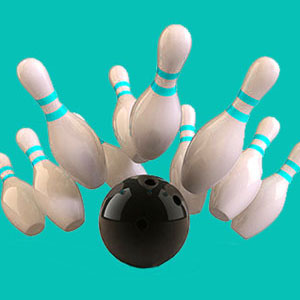
Bowling with a herniated disc can be a frightening experience for newly diagnosed patients. In fact, we receive many letters from bowling aficionados who were recently told that they must be careful after positive diagnosis of one or more intervertebral disc abnormalities. These people are often terribly conflicted about whether or not to continue participating in their beloved pastime, which is completely understandable. We are highly empathic to anyone who finds themselves at odds between embracing a passion and doing what they have been told might be the safer path towards less pain and better health, even if it means abandoning their great love.
Bowling is well known as an activity that can cause or exacerbate back pain. Although most commonly associated with lower back issues, we can say for sure that we have seen many people suffer escalated neck symptoms and even upper back symptoms in association with bowling participation. However, we stop short of universally saying that the activity was the direct cause of these symptomatic flare-ups, especially when linked to herniated discs specifically.
This interesting article delves into the idea of continuing to be an active bowler, despite having one or more herniated discs. We will discuss risk factors of bowling with a herniated disc and provide helpful guidance for anyone who must decide their future path regarding bowling after a bulging disc diagnosis.
Bowling with a Herniated Disc in the Lower Back
Most herniated discs are diagnosed at L4/L5 and/or L5/S1. This area at the end of the spinal column suffers the most marked degeneration at the earliest age and is often already deteriorated substantially by the age of 30 or so. In our research, we find intervertebral bulging and herniation affects more people at these locations than not, when considering adults over the age of 40. This means that more than half of all bowlers over age 40 probably fall into the group that demonstrates some variety of disc abnormality in the lower spine, although many have not been diagnosed or even have any idea of the atypical spinal disc condition expressed by their lumbar spine.
One must also consider that disc desiccation, also commonly known as degenerative disc disease, is almost universal in adults past age 40 and is also most typically found at these 2 specific intervertebral levels. It is well known that desiccation encourages herniation, so even people who do not currently demonstrate herniation have a fair chance of developing it in the future.
Herniated discs in the lumbar spine are relevant to bowling, since the activity utilizes the vertebral column and muscular tissues located here for virtually every aspect of the game. The lumbar spine is actively engaged when actually bowling, especially just before and during ball release. The lumbar spine is also engaged when retrieving the ball from the return.
Bowling with a Herniated Disc in the Neck
People with cervical disc herniations and bulges can also feel afraid of bowling due to the possibility of escalation of symptoms. Most cervical disc abnormalities are also related to degeneration in the neck region and typically occur following desiccation of one or more discs located between C4 and T1. This region includes the C4/C5, C5/C6, C6/C7 and C7/T1 discs.
While cervical disc herniation is not as common as lumbar varieties of disc abnormality, incidence of intervertebral bulging and prolapse is still very high in the general population, accounting for about 35% to 45% of adults over the age of 40.
Cervical herniated discs are relevant to bowling since the neck is actively engaged in the approach to ball release, as well as when the ball is actually thrown.
Bowling with Disc Pain
Many doctors caution their patients to be careful when bowling, or not to bowl at all, following diagnosis of a herniated disc. However, there is little evidence that this advice is logical or prudent, since such guidance can incite the nocebo effect, generating additional pain rather than helping to relieve symptoms.
Research shows that most herniated discs are not pathological and do not require any special care or considerations. It is certainly true that bowling can induce back pain, but this fact is often unrelated to any herniated disc that may or may not exist in a given patient, since most instances of bowling-related dorsalgia are muscular in nature and not spinally-motivated.
Therefore, our experience generally tells us that bowling is usually fine for most herniated disc patients, although they should maintain all the best practices that will reduce the chance of suffering any type of dorsal injury, such as perfect form and posture, as well as always being mindful of how the body is working during the game.
Remember that one of the most widely used treatments for herniated discs is physical therapy and this path involves highly strenuous exercises the help build the strength and endurance of the back muscles. Bowling can qualify as an excellent constructive exercise for the back, legs and other parts of the anatomy and should not be excluded simply because of a herniated disc. After all, if all bowlers with degenerated, bulging and herniated discs were to suddenly stop, the remaining population of bowlers would be about 10% of what it is right now. This is how many people are currently bowling pain-free with various spinal disc abnormalities and enjoying themselves in the process.
Before getting on the lanes, be sure to ask your physical therapist for guidance that is best suited for your specific condition, including any cautions about bowling with a herniated disc that might apply to you.
Herniated Disc > Herniated Disc Exercises > Bowling with a Herniated Disc





